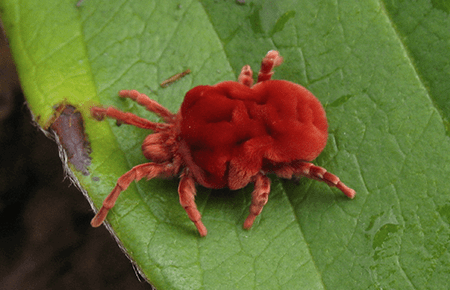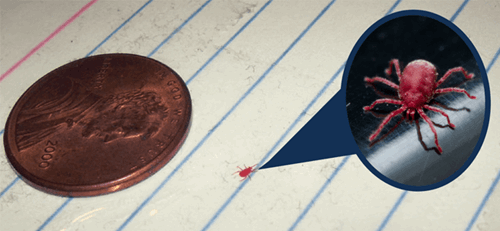Get a free estimate
If you have questions about our services, plans, or pricing we are here for you. Fill out the form below and we will communicate with you by email (and of course provide you with a free estimate).
MARCH 29 2022 /
Those red bugs creeping around your home have a name: clover mites. Their color many seem alarming, but fret not; these little guys are harmless. So how did they get into your home, and what can you do about them? We have all the answers!
The tiny red bugs that you see are clover mites. To the naked eye, they appear no larger than the head of a ballpoint pen.
Let's break it down: a mite is defined as a "minute arachnid", so these tiny pests are related to spiders, scorpions, and ticks. Unlike their cousins, however, They do not feed on humans or pets, or even bite them in defense.

This may be surprising considering their bright red color, but this coloring has nothing to do with sucking blood, and everything to do with their biological makeup.
Since they aren't after you, it seems that they must be after your home, but that is also not the case. Clover mites do not cause structural damage; they are simply just an annoying pest.
Red clover mites are attracted to heavily fertilized lawns. They feed on grass, plants, weeds, and clovers (surprising, right).
If you find yourself with an infestation outside your home, they are most likely hanging out on a wall on the south side, as they love sunny areas.
If they are inside your home, it is likely that you do not have enough space between the foundation of your home and your lawn.
These small red insects are no larger than a pinhead, they can slip through the tiniest cracks in your foundation that you might not even be able to see.
Females reproduce through a process called parthenogenesis, which allows her to lay eggs without any help from a male (talk about an independent woman who don't need no man).
She can lay up to seventy eggs at a time, and those eggs can mature in thirty days or less. In fact, only female clover mites populate the United States, so if you see one clover mite, you can be almost certain that there are more.
What you see on the outside of a clover mite is what you get on the inside as well. If you smash one of these bugs into your carpet or wall, you are going to be left with a red stain.
The safest alternative to remove these pests is to vacuum them up. You can also try wiping them up with a wet towel or sponge, but be careful not to squish them.
You can certainly try! Survey the foundation of your home, and seal up any and all cracks (this will be helpful with any pests, not just clover mites).
Be sure that there is at least eighteen inches between the foundation of your home, and the start of your grass.
It will be even more helpful if you fill that space with something such as gravel or sand.
These steps will help keep clover mites out of your home. If you are finding them in your yard, be sure not to over-fertilize. They love gardens that are abundant and rich, so keep it simple.

⭐ Locate and seal potential entry points around the home with caulk or similar materials.
⭐ Create an area between your foundation and lawn that is free from grass and other foliage. An 18-20" gravel or stone barrier between the lawn and the foundation will help reduce the incidences of clover mites.
⭐ Reduce excessive moisture around the home’s foundation, specifically paying attention to downspout areas and sprinkler systems. Keeping moisture away from the home will also reduce the likelihood that other pests will be drawn to your lawn during periods of little rain.
While there are some home remedies that may be effective, if you seem to have a large infestation on hand, it is best to leave it to the professionals.
Over-the-counter pesticides are often not catered to a specific pest, which decreases their chance of being effective.
The experts here at American Pest have specific products to eradicate your "tiny red bug" problem as swiftly and efficiently as possible.
If you have questions about tiny red bugs or any other insect pests, contact us and we'll help you to solve all your difficult pest problems!